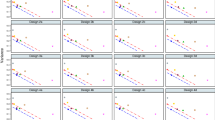Abstract
In conventional empirical likelihood, there is exactly one structural constraint for every parameter. In some circumstances, additional constraints are imposed to reflect additional and sought-after features of statistical analysis. Such an augmented scheme uses the implicit power of empirical likelihood to produce very natural adaptive statistical methods, free of arbitrary tuning parameter choices, and does have good asymptotic properties. The price to be paid for such good properties is in extra computational difficulty. To overcome the computational difficulty, we propose a ‘least-squares’ version of the empirical likelihood. The method is illustrated by application to the case of combined empirical likelihood for the mean and the median in one sample location inference.
Similar content being viewed by others
References
Chen, S. X. (1993). On the coverage accuracy of empirical likelihood confidence regions for linear regression model, Ann. Inst. Statist. Math., 45, 621–637.
Chen, S. X. (1994). Comparing empirical likelihood and bootstrap hypothesis tests, J. Multivariate Anal., 51, 277–293.
Chen, S. X. and Hall, P. (1993). On the calculation of standard error for quotation in confidence statements, Statist. Probab. Lett., 19, 147–151.
Hall, P. and La Scala, B. (1990). Methodology and algorithms of empirical likelihood, Internal. Statist. Rev., 58, 109–127.
Hall, P. and Owen, A. (1993). Empirical likelihood confidence bands in density estimation, Journal of Computational and Graphical Statistics, 2, 273–289.
Hansen, L. P. (1982). Large sample properties of generalized method of moment estimators, Economeirica, 50, 1029–1054.
Jing, B. Y. (1995). Some resampling procedures under symmetry, Austral. J. Statist., 37, 337–344.
Owen, A. (1988). Empirical likelihood ratio confidence intervals for a single functional, Biometrika, 75, 237–249.
Owen, A. (1990). Empirical likelihood ratio confidence regions, Ann. Statist., 18, 90–120.
Owen, A (1991). Empirical likelihood for linear model, Ann. Statist., 19, 1725–1747.
Press, W. H., Flannery, B. F., Teukolsky, S. A. and Vetterling, W. T. (1992). Numerical Recipes in C, Cambridge University Press, Cambridge.
Qin, J. and Lawless, J. (1994). Empirical likelihood and general estimating functions, Ann. Statist., 22, 300–325.
Stigler, S. M. (1977). Do robust estimators work with real data? (with discussion), Ann. Statist., 5, 1055–1098.
Wood, A. T. A., Do, K.-A. and Broom, B. M. (1996). Sequential linearization of empirical likelihood constraints with application to U-statistics, Journal of Computational and Graphical Statistics, 5, 365–385.
Author information
Authors and Affiliations
About this article
Cite this article
Brown, B.M., Chen, S.X. Combined and Least Squares Empirical Likelihood. Annals of the Institute of Statistical Mathematics 50, 697–714 (1998). https://doi.org/10.1023/A:1003760813552
Issue Date:
DOI: https://doi.org/10.1023/A:1003760813552



